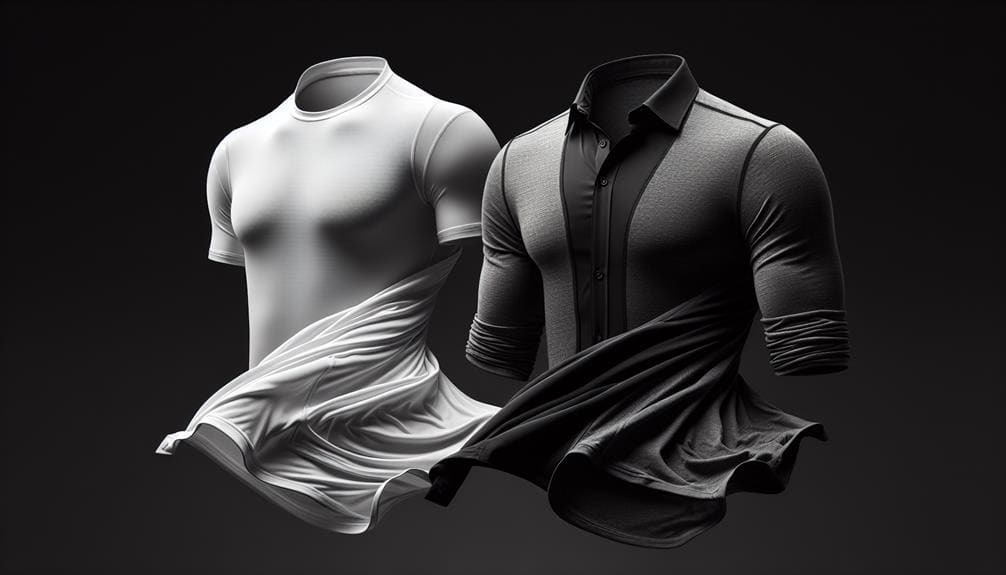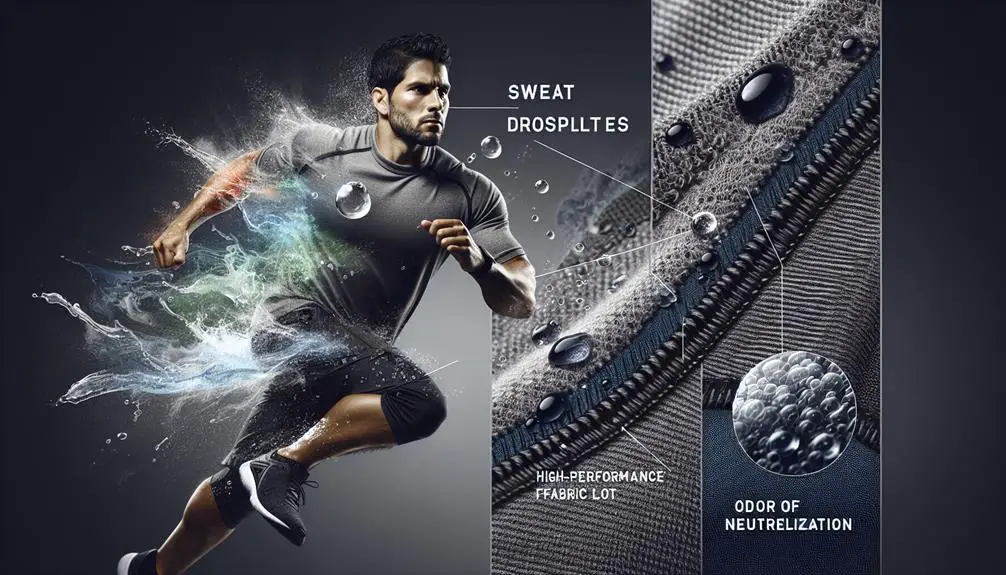Master odor control in moisture-wicking tees with silver ion technology. Silver ions bind to bacteria cell walls, providing long-lasting freshness even after multiple wears. Natural anti-odor agents like tea tree oil and bamboo fibers inhibit bacterial growth, keeping your tee smelling fresh. Choose fabrics like polyester, nylon, or merino wool for excellent moisture management. Odor-resistant finishes actively combat microbes, ensuring long-lasting freshness. Remember to air dry, avoid fabric softener, and address stains promptly for peak performance. Utilize advanced technologies and care tips to maintain odor-free activewear. Discover the secrets to long-lasting freshness in your moisture-wicking tees.
Key Points
- Silver Ion Technology enhances fabric's odor-fighting abilities.
- Natural anti-odor agents like tea tree and bamboo inhibit bacteria growth.
- Fabric composition such as polyester and nylon aids in moisture management.
- Odor-resistant finishes actively combat odor-causing microbes.
- Follow specific washing and care tips for optimal odor control performance.
Silver Ion Technology
When integrating silver ion technology into moisture-wicking tees, manufacturers enhance the fabric's ability to combat odor-causing bacteria. This technology works by releasing positively charged silver ions that bind to the negatively charged cell walls of bacteria, disrupting their normal function and preventing odor formation. The performance benefits of silver ion technology include long-lasting odor control, even after multiple wears and washes. Additionally, silver ions have been shown to have a high efficacy against a broad spectrum of bacteria, making them a reliable choice for odor management in activewear.
In terms of environmental impact, silver ion technology raises concerns due to the potential release of silver ions into the environment during the garment's lifecycle. While some studies have indicated minimal environmental impact from silver ion-treated textiles, it's essential for manufacturers to contemplate end-of-life disposal methods to minimize any potential harm. Overall, when used responsibly and with proper disposal practices in place, silver ion technology can provide significant performance benefits in moisture-wicking tees.
Natural Anti-Odor Agents
Incorporating natural anti-odor agents into moisture-wicking tees enhances the fabric's ability to combat undesirable odors. Essential oils, known for their aromatic properties, have gained popularity as natural odor-fighting agents. These oils, such as tea tree oil or lavender oil, possess antimicrobial properties that help inhibit the growth of odor-causing bacteria on the fabric.
Another natural anti-odor agent gaining recognition is bamboo fibers. Bamboo has inherent properties that make it naturally resistant to odor-causing bacteria. When integrated into moisture-wicking tees, bamboo fibers can help reduce the accumulation of unpleasant odors, keeping the garment fresher for longer periods.
Fabric Composition Matters
The fabric composition of moisture-wicking tees greatly influences their ability to control odor. When considering fabric composition for odor control in moisture-wicking tees, focus on the following key points:
- Moisture Management: Fabrics like polyester, nylon, and merino wool excel in moisture management. Polyester efficiently wicks sweat away from the skin, keeping you dry and reducing the buildup of odor-causing bacteria. Nylon is durable and provides excellent moisture-wicking properties, while merino wool naturally wicks moisture away from the body, preventing bacterial growth that causes odors.
- Performance Benefits: Blends of synthetic fibers like polyester and spandex offer enhanced performance benefits by combining moisture-wicking properties with stretch and durability. These blends guarantee that the tee maintains its shape and functionality even during intense physical activities, providing maximum comfort and odor control.
Choosing moisture-wicking tees with the right fabric composition is vital for effective odor control and overall performance during various activities.
Odor-Resistant Finishes
Utilize odor-resistant finishes to enhance the longevity of odor control in moisture-wicking tees. Odor neutralizing treatments are a key component of these finishes, actively combating the bacteria and fungi responsible for unpleasant smells. By inhibiting the growth of odor-causing microbes, these treatments effectively reduce the buildup of odors within the fabric. This prevention mechanism greatly extends the freshness of moisture-wicking tees during wear, making them more durable and reliable for long-term use.
Microbial growth prevention is an essential function of odor-resistant finishes. Through the application of antimicrobial agents, these finishes create an inhospitable environment for bacteria and fungi to thrive. By impeding the growth and proliferation of these microorganisms, the development of odors is curtailed, ensuring that moisture-wicking tees remain odor-free for an extended period. Incorporating odor-resistant finishes with microbial growth prevention capabilities into the design and production of moisture-wicking tees is vital for maintaining excellent odor control performance throughout the garment's lifespan.
Washing and Care Tips
To maintain the peak performance and longevity of moisture-wicking tees, follow specific washing and care tips meticulously. When it comes to washing and caring for your moisture-wicking tees, attention to detail is key. Here are some essential tips to guarantee your tees stay in top condition:
- Drying Techniques: Opt for air drying or using a low heat setting in the dryer to prevent damage to the fabric's moisture-wicking properties.
- Avoid Fabric Softener: Refrain from using fabric softener as it can leave a residue on the fabric, reducing its moisture-wicking abilities over time.
- Stain Removal and Ironing Tips: Address stains promptly with appropriate stain removers that are gentle on moisture-wicking fabrics. When ironing, use a low heat setting to prevent heat damage to the fabric.
Frequently Asked Questions
Can Moisture-Wicking Tees With Odor-Resistant Finishes Be Worn Multiple Times Before Needing to Be Washed?
You know, these innovative moisture-wicking tees with odor-resistant finishes are game-changers. They let you rock that fresh scent longer, reducing washing frequency and the environmental impact. Embrace the sustainability without compromising cleanliness.
How Effective Is Silver Ion Technology in Controlling Odor in Moisture-Wicking Tees Compared to Natural Anti-Odor Agents?
When comparing silver ion technology to natural anti-odor agents in moisture-wicking tees, silver ions exhibit superior effectiveness in controlling odor. The mechanisms of silver ions offer potent and long-lasting odor control compared to the properties of natural agents.
Are There Any Potential Health Risks Associated With the Use of Odor-Resistant Finishes in Moisture-Wicking Tees?
Concerns about health risks tied to odor finishes in moisture-wicking tees are valid. Evaluating the longevity of odor control against potential health impacts is essential. Prioritize safety when selecting products for your well-being and comfort.
Do Different Fabric Compositions in Moisture-Wicking Tees Affect How Well They Control Odor?
Different fabric blends in moisture-wicking tees impact odor control performance. The composition influences how effectively the tee manages odors. Understanding the fabric blend's role in odor control can lead to selecting tees that offer peak performance and comfort.
Can Using Certain Types of Detergents or Fabric Softeners Affect the Odor-Resistance of Moisture-Wicking Tees?
Using certain detergents impacts moisture-wicking tee odor resistance. Fabric softeners decrease longevity. Choose detergents compatible with the tee's fabric to maintain peak odor control. Avoid fabric softeners for extended tee freshness.




